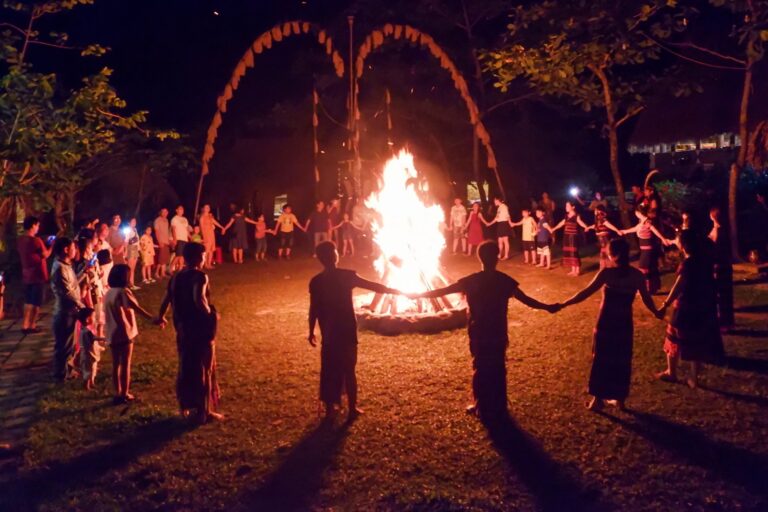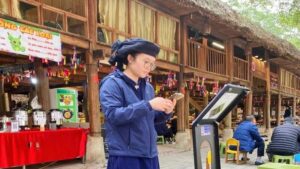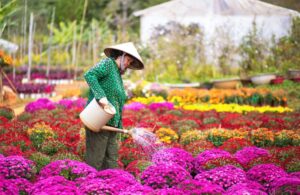It was the fourth time I had been to Ha Long Bay, which covers 1,553 sq km and includes thousands of limestone karsts and isles of various sizes and shapes. I visit this landscape, not because of its recognition as one of the seven natural wonders of the world, but because of its hidden beauties.
Similar to previous occasions, I usually prefer lying on the beach and eating delicious seafood or visiting caves. However, it came to me as a surprise when Doan Tung, a tight-lipped travelling partner, asked our group to go see one of three floating villages named Ba Hang (Three Caves), a well-known site for fish farming.
After buying tickets at a total cost of VND1.4 million (US$66), we were shocked at the large number of visitors set to join us on the trip, which only increased our curiosity about our destination. The fee for individuals is around $300.
Setting off at 2pm under a scorching sun, the large vessel slowly carried us to the village, passing wonders such as the Dinh Huong Islet as well as the caves of Thien Cung, Dau Go and Ti Top, amongst others.
Ngo Huy Thanh, a young waiter onboard commented, "I have never seen such a large number of tourists before."
In response to a question about the village, he said, "There are about 50 households farming with fish, a process which has brought some level of prosperity to the once poor community."
Upon reaching the village, no one could take their eyes off the 40 floating structures constructed from wooden panels and Styrofoam to help keep them afloat.
Thanh said the cost of a floating house depended on how much wood was used and that a dwelling of around 17sq.m, enough for a family of five, was normally priced at around VND40 million (US$1,900).
Thanh added that it was the only floating primary school in the district which was built in 2000. The school, however, was not big enough for all the local children. He told us about the village without forgetting the ship's service: "We offer visitors free cooking services of seafood which can be bought from the floating villages. Additionally, we provide kayaking in the bay. Anyone except children can take part in these types of entertainment during the journey."
The ship left us at the house of Nguyen Van Tro, a local fish farmer who looked much older than his 40 years of age.
"The bay includes about 167 households scattered across four floating villages including Cua Van, Ba Hang, Cong Vien and Cap Lai. Most houses here were built in 2002 and are not only used as homes, but as farming facilities for such fishes as gio (Black King), song (Garrupa), mu (Grouper), chim trang (Swallow-fish), tu hai (Snout Otter Clams), sam (Limulus), amongst others," Tro told us. "Each household earns around VND7 million (US$330) a month, which has helped improve many lives over the past eight years."
"I started my business in 2004. It was a really tough time at first because all the things I had, including the floating house, baby fish and other aquatic products, were bought on credit at a total cost of VND30 million (US$1,400)," he explained. "My one-time floating house comprised of only wood, cellular panels and nets which allowed me to raise no more than 20 fish. Now I own a bigger facility capable of containing up to 100."
He added that a storm last year had brought him many nightmares, having wreaked havoc across most of Ba Hang. His home survived the tempest, but nearly half of his produce, valued at VND50 million (US$2,400), went to waste.
"It seemed to me that I had lost everything. Thanks to support from local authorities however, we were able to clean up some of the mess," Tro said.
Tro added that he has not seen any help from any other groups or people except for local helps. Last year, he met a foreign TV crew who told him that they would screen the village, which could help attract foreign concern. He did hope someone to come there to teach him and his villagers how to keep the water cleaner and how to grow fish effectively.
Nguyen Thi Can, a snack and water vendor, suddenly chipped in, "That's not the whole story. The province provided families who suffered severe damage VND2 million (US$97) each while others received heath-care equipment, life buoys, noodles and rice, amongst others. I also received monetary assistance from a Japanese family. "
Having resided in the village for over 64 years, she added, "I have sold groceries for nearly 20 years. It has helped me earn between VND100,000 to 200,000 a day. It's enough for my daily life."
"I've had one son and two daughters, both of whom live far away from here. My son died in the storm. Now my fate is in nobody's hands. I have to take care of myself when I get sick."
The woman's story reminded me of an article I read about a 2001 provincial resolution aimed at moving floating village residents to land, but which has yet to take effect.
In the article, Hoang Quang Hai, head of urban management, said, "The unclear policy prevents us from moving people. It lacks detail on how to assist them when they move to land. Moreover, most of them do not know what to do once they get there because their entire lives have revolved around the sea and fishing."
Vu Duc Minh, deputy director of the Van Canh Conservation Centre, in the story, said: "Local business partly affects the environment which has caused the municipal authority to move households to land. We persuade them to resettle by words only."
I asked Tro and Can whether they would consider leaving their floating homes and current careers for a new life on land. Both answered that they were too old to restart life and needed more help where they are.
"The shortage of electricity, schools, commodities and clinics, amongst others, does little to disturb our lives out on water. Additionally, I am satisfied with the money I earn here," Tro saidø.
"I have a seven year-old daughter studying at the floating primary school. So we only focus on our floating lives here. Maybe in the next three years, authorities will build a new secondary school for us," Tro said.
"I would be wary of leaving a monthly income of VND3 million (US$140) behind. If possible, I hope authorities will build us a clinic and old people's home," Can added.
At 4pm, while people were absorbed in buying seafood, Thanh suddenly interrupted our conversation, shouting: "Everybody, please come back to the ship."
Even though my journey ended, my curiosity about floating village life did not, and I will return here as soon as possible.
















